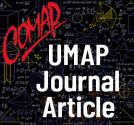Full Member Resources
COMAP offers members access to numerous mathematics and modeling programs, products, and materials in a variety of collections and formats. Our online library has more than 1500 resources. This page lists resources with most recent first. Please use the Search box or the filter options in the Find Resources menu to assist in locating desired products. For additional assistance or if you have questions, please don't hesitate to contact us.
Executive Mathematics
The red ink informed Jim Washam that he had made a $400 mathematical error. Washam, a bank vice-president, was glad tha…
Adaptive Methods
Adaptive methods have their foundation in the mathematical field of control theory. The basic idea of an adaptive metho…
Applied Mathematics in China
Last fall a delegation of U.S. college mathematics educators visited a dozen Chinese universities at the invitation of…
Hercules and the Hydra
Hermles, the greatest hero of Greek mythology, was the strongest man on earth and supremely self-confident in his stren…
Game Theory and Nuclear Deterrence
The theory of nuclear deterrence seems, at first glance, crudely simple. Since both the United States and the Soviet Un…
The Lifeguard Problem
The following exercise appears in some version in almost every calculus textbook (e.g., [Fraleigh 1985, 1851; [Purcell…
Difference Equations in Genetics
The evolution of many allele frequencies can be understood through the use of difference equations. Let n represent (eq…
Parabolic Wave Equations
The last fifteen years or so have seen enormous research activity in the development of parabolic wave equations (PWEs)…
Algebraic Geometry in CAD / CAM: The Role of 19th Century Mathematics in Geometric Modeling
Geometric modeling is the representation and manipulation of geometic data in a computer. It is the mathematics that is…
The Curious History of Trigonometry
Current trigonometry texts begin with trigonometric ratios, continue through the solution of right and other triangles…
Genetic Algorithms in Optimization
Genetic algorithms (GAS) are iterative processes for finding good solutions to optimization problems. GAS operate on a…
Mr. Markov Plays Chutes and Ladders
Readers with children (or readers who were themselves once children) may be farnilar with the simple board game of Chut…
A Tour of Graphical Typesetting on the Macintosh
This article began as a comparative review of Macintosh programs for producing publication-quality graphics, inspired b…
Optimal Blackjack Strategy with 'Lucky Bucks'
In the casino game blackjack or 21, mathematically determined best plays have been calculated by various mathematicians…
Mathematical Developments in 1992
Mathematical research in 1992 revealed a surprising connection between a newly discovered means of checking proofs and…
Timing the Blind Watchmaker: Comments on an Evolution Model of Richard Dawkins
In his book The Blind Watchmaker, Richard Dawkins [1986al argues for the feasibility of evolution using a simple stocha…
Municipal Recycling: Location and Optimality
Recycling is difficult for local governments because it is a multidimensional problem. Not only are there biological, e…
Commentary on Rotations in 3-Space
The problem of computing rotations in three-dimensional Euclidean space has been widely studied. It arises in many area…
Tank Calibration: Practical Examples in Approximation Techniques
The topic of tank calibration provides an ideal setting for introducing important ideas in computational mathematics. T…
Professors' Commentary: The Politics of Course Time Slots
When one of the authors (Campbell) was a graduate student at Cornell in the late 1960s, he never ceased to be amazed at…
The Dynamical Systems Health Center: A Mathematical Model of a Diet and Exercise Program
This paper began as a class assignment for Prof. James Sandefur's Discrete Dynamical Systems course at Georgetown Unive…
Practitioner's Commentary: Diet Models
Author Cherry presents in this issue of The UMAP Iournal a mathematical model of the effects of diet and exercise on hu…
A Case Study in Scheduling Courses
A frequent problem that college students face is that of scheduling their courses. Part of the problem stems from requi…
The Solow Model of Economic Growth
The production of goods by a country depends on the capital available for investment and the number of workers in the l…
Practitioner's Commentary: Card Shuffling
Brad Mann has done an excellent job of explaining various card-shuffling results. That of Bayer and Diaconis is particu…
Mathematical Developments in 1993
Mathematical discoveries in 1993 included a new polyhedron that will fill space only aperiodically, an algorithm for en…
Chase Problems
College football is a favorite American spectator sport, so a differential equations project involving football is almo…
How Many Times Should You Shuffle a Deck of Cards?
How many times do you have to shuffle a deck of cards in order to mix them reasonably well? The answer is about seven t…
The Combinatorics of Mancala-Type Games: Ayo, Tchoukaillon, and l/Pie
Around the world, hundreds of different kinds of mancala games have been observed [Deshayes et al. 1976; Murray 1978; R…
Realistic Calculus Optimization
Many students are introduced to mathematical modeling through the max/min problems of one-variable calculus. However, a…
Optimal Klappenspiel
The game Klappenspiel (flipping game) is a traditional German game of flipping tiles according to dice rolls. In this p…
Frustration solitaire
In this expository article, we discuss the rankderangement problem, which asks for the number of permutations of a deck…
Playing Konane Mathematically: A Combinatorial Game-Theoretic Analysis
This article presents a combinatorial game-theoretic analysis of Konane, an ancient Hawaiian stone-jumping game. Combin…
Bidding Optimally on ' The Price Is Right '
What is the best strategy in the bidding game on The Rice Is Right? Over the last twenty-four years, the television gam…
On Words and Symbols
College catalogs, not the most edifying reading available on most campuses, do occasionally reflect trends that signal…
Find Resources
Browse More Resources
Search

